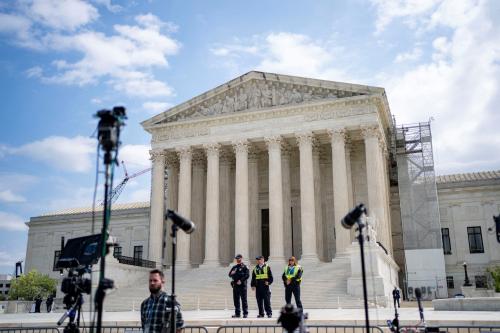If the national television networks want a reality-based series that has more twists and turns than
Survivor II, Temptation Island and Boot Camp combined, they should take a look at today’s
presidential appointments process. It lasts long enough to generate a full season of programming, and
provides the perfect mix of endurance and disaster.
The first episode—”Presidential Appointee”—would be easy to script. It could open as the nearly 3,000
Bush administration appointees confront the 60 pages of forms they will have to complete to enter the
process, and zoom in as each one comes to the realization that almost all of the forms have to be filled
out on a typewriter. The audience would only increase in Episode II as nominees wander through the
tropical forest of clearance and confirmation. Viewers could share the panic as the FBI starts
interviewing former neighbors, employees, ex-spouses, marriage counselors and personal friends.
Viewers also could venture why owning Coca Cola stock might constitute a conflict of interest for
Department of Defense appointees (hint: the senior leadership might have something to do with the
choice of soft drinks for military posts). Unfortunately, what makes for good television does not make
for good government. The White House and Senate are right to ask hard questions about a candidate’s
qualifications, conflicts of interest and potential embarrassments, even if doing so adds time to the
process. But most of the delays are due to overlapping forms, understaffing in the White House
personnel office, a steady increase in the number of political jobs and a misuse of the appointments
process by presidents and senators.
The proof is in the views of the Reagan, Bush I and Clinton administration senior appointees recently
interviewed for a joint study by the Brookings Institution and Heritage Foundation. According to the
appointees, there is virtually no stage of the process that does not take longer than it should, from White
House review to final Senate confirmation. President George W. Bush will be lucky to have his entire
Cabinet and sub-Cabinet confirmed by Nov. 1, nine months after Inauguration Day. The delays will
almost certainly increase in the future as each new administration adds its own questions to the
ever-lengthening process.
The forms are a peculiar form of bureaucratic torture. Initially designed to ferret out Communists during
the McCarthy era and prevent conflicts of interest in the wake of Watergate, the forms have been slowly
expanded to prevent every possible embarrassment. Many of the questions are repeated with just
enough variation to demand an entirely new formulation, first in the White House personal data
statement, next in the financial disclosure forms, and yet again in the assorted FBI questionnaires. It is no
surprise that half of the nominees report that they sought outside help to address legal and financial
issues.
The delays hardly end once nominees leave the executive branch. The Senate introduces an entirely new
source of often unpredictable delay, including personal holds, threatened filibusters, scheduling conflicts,
and frequent recesses. If the Bush administration does not get its Cabinet confirmed by late October
when the Senate adjourns for the year, it may have to wait until mid-January to get restarted. Under the
best of circumstances, the Senate can move at subglacial speed. But with so much at stake in the 2002
midterm elections, and a host of Senate Democrats angling for the 2004 presidential nomination, the
upper chamber is likely to be gone often over the next two years.
This process would make perfect sense if there were some value in discouraging talented Americans
from accepting the call to service, or some democratic protection in the high vacancy rates such a
system produces.
Luckily, the Senate Governmental Affairs Committee believes otherwise, and has begun thinking about a
range of reforms that would streamline the process and increase the odds that America’s best and
brightest will serve. Although action is not likely to come in time to rescue Bush’s appointees, the Senate
has a unique opportunity to help future presidents move more quickly to take control of the federal
government. Unless something is done soon to cut the delays, future administrations may find themselves
leaving office before they finish arriving.



Commentary
Op-edThe Breaking Down of Presidential Appointments
April 11, 2001